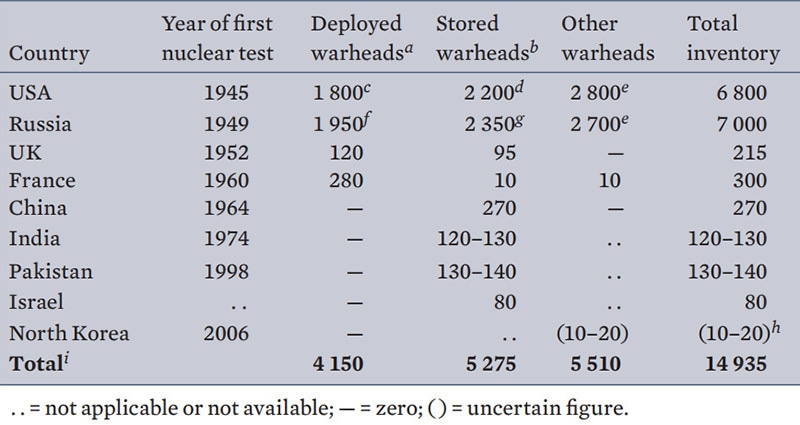Although global nuclear stockpiles witnessed a drop in 2017 compared to last year, Pakistan and India continue to expand its military fissile material production capabilities on a scale that may enable a significant increase in weapons inventories over the next 10 years, the Stockholm International Peace Research Institute (Sipri) said in a publication titled "Trends in world nuclear forces, 2017".

The global nuclear stockpile has decreased to 14,935 warheads in 2017 from 15,395 in early 2016.
At the beginning of this year, the United States, Russia, United Kingdom, France, China, India, Pakistan, Israel and the Democratic People’s Republic of Korea all possessed approximately 4,150 operationally deployed nuclear weapons, the Sipri report said.

Russia possesses the greatest number of nuclear warheads with 7,000, followed by the US with 6,800. Both have reduced their stockpiles over the past decade, albeit at a slowing rate, the report claimed.
The arsenals of other countries are considerably smaller, but all are either developed or deployed new weapons systems or intend to do so, according to the report. Pakistan and India both, for instance, are working on developing new land, sea and air-based missile delivery systems.
Pakistan
As of January 2017, Pakistan was estimated to possess a stockpile of up to 140 warheads, according to the Sipri report. This showed a marked increase from the 120–130 warheads estimated in the research institute's data for 2016.
Pakistan has been expanding its main plutonium production complex at Khushab, Punjab, which consists of four operational heavy-water nuclear reactors and a heavy-water production plant, as well as constructing a new reprocessing plant at another site.
The report goes on to state that some non-governmental analysts have predicted that the size of Pakistan’s nuclear stockpile will increase significantly over the next decade, although estimates of the increase in warhead numbers vary considerably depending on assumptions about Pakistan’s production capabilities.
While aircraft constitutes as Pakistan's most developed nuclear payload delivery system, recently the government has focused on expanding its capabilities to nuclear-capable land-based ballistic and cruise missiles.
Pakistan currently deploys two types of road-mobile short-range ballistic missiles and has developed two types of medium-range ballistic missiles. The Shaheen-III missile ─ a longer-range variant under development ─ will be capable of striking targets throughout India.
A short-range nuclear-capable missile has also been developed with the apparent use intention of being used in tactical nuclear roles and missions.
"The development of so-called battlefield nuclear weapons reflects the pursuit of what Pakistan officials describe as a ‘full-spectrum deterrence’ posture," states the report.
"Their purpose is to offset India’s superior conventional forces in limited conflict scenarios."
"Pakistan has acknowledged that it is seeking to match India’s nuclear triad by developing a sea-based nuclear force," the report adds, acknowledging that there has been "considerable speculation" that the sea-based force will initially consist of nuclear-armed sea-launched cruise missiles deployed on submarines or on surface ships.
India
By the onset of 2017 India was estimated to have a nuclear arsenal of up to 130 weapons, the report stated, and this represented an increase in the country's nuclear stockpile from the 110–120 warheads estimated in the Sipri nuclear data for 2016.
The article goes on to note that India is moderately expanding the size of its nuclear weapon stockpile as well as its infrastructure for producing nuclear warheads.
"It [India] plans to build six fast breeder reactors, which will significantly increase its capacity to produce plutonium for weapons," reads the report. India plans on expanding its uranium enrichment capabilities with the construction of a new "un-safeguarded" gas centrifuge facility, the report claims.
"India’s expanded centrifuge enrichment capacity has been motivated by plans to build new naval propulsion reactors, but the potential excess capacity could also signify its intent to move towards thermonuclear weapons by blending the current plutonium arsenal with uranium secondaries."
India continues to maintain focus on developing the Agni family of land-based nuclear-capable ballistic missiles ─ flight tests of a new road-mobile, canister-launched ballistic missile, the Agni-V, is reported to have a near-intercontinental range and possess the capability of reaching targets throughout China.
The Agni-V is expected to be inducted into service in 2017.
India continues to develop the naval component of its triad of nuclear forces in pursuit of an assured second-strike capability.
Sipri is an independent international institute dedicated to research into conflict, armaments, arms control and disarmament. Established in 1966, SIPRI provides data, analysis and recommendations, based on open sources, to policymakers, researchers, media and the interested public.













































